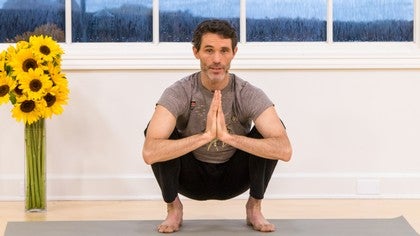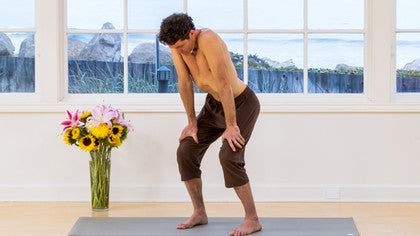Description
About This Video
Transcript
Read Full Transcript
(ocean waves crashing) So as a practitioner of traditional Chinese medicine and Ayurveda, one of the things I discovered very quickly into my training almost 20 years ago was that we are junior scatologists. And scatology is the science of poop, and in all traditional medicines, that particular subject has immense therapeutic clinical informative value, so we inevitably end up talking about it, and nowadays, there's sort of epidemic proportions of people who are having a difficult time with their digestion, many of which who are constipated. So today is going to be the poop whisperer session, which is going to be about you finding ways to be more regular from using some Ayurvedic techniques as well as some yoga techniques. So first, a little context, which is to say that from the Ayurvedic perspective, from my clinical experience, there's two main types of constipation. From an Ayurvedic perspective, Vatta and Kapha type of constipation.
In the Vatta case, you're usually gonna see something where the stools become dry, they'll often be hard to pass. They'll often become small and even pellet-like. Sometimes there's a lot of gas and even pain with that kind of constipation. Another Vatta type of constipation is the kind of fluctuating irritable bowel kind of profile where you have constipation alternating with diarrhea without ever having things really set up into a good normal stool. The other kind of constipation is Kapha type of constipation, and this is quite different, because it's characterized by a situation where you're experiencing a feeling of incompleteness with your bowel movement.
Whereas the texture of the stool is often soft, and even kind muddy, the feeling is that you could evacuate more but you're just not able to, and you often have a kind of, almost like a damp or heavy kind of feeling in the lower abdomen that you experience throughout the day. So, to get into a few things from Ayurveda before we do some yoga practices, I'll start again with Vatta type of constipation, and give you some suggestions for that. So one thing with Vatta type of constipation, Vatta's very closely associated with the nervous system. So you want to stabilize and ground your nervous system as much as possible, and one of the best ways to do that is to get a nice rhythm and routine in your life. If your life is very erratic and very chaotic, that can actually be a causative factor in a big way for Vatta type of constipation.
Another thing that's important to do is to make sure that you're actually consuming foods that are going to be warming, moistening foods, foods that have plentiful amounts of fats in them, especially things like seeds are wonderful, and vegetable oils, things like avocado, coconut oil. All those things are great for actually promoting lubrication of the bowel from the basis of oiling, internally oiling. Things like ghee are used in Ayurveda quite prominently to help with that process, as well as you can do small oil enemas, but that's a medical thing, and it's better to actually talk to somebody who's knowledgeable about how to do that. I'm not gonna recommend that or talk more about it. Other than that, it's also just to avoid foods that are really dry, really cold, kind of foods that would actually pull moisture out of the GI tract, and that's gonna be anything that's dried, as well as things like processed grains, where it's crispy and crackly.
Things like popcorn, what actually has a net effect to dehydrate you in the process of digesting them, as well as excess meat consumption. That can actually constipate people for the same exact reason. So those are a few dietary kind of ideas. I wanna give you a few kind of supplemental type of things that you can think about doing that are really really simple. So the kind of primary herbal compound for helping to regulate the bowels in Ayurveda is called triphala.
It also happens to luckily be the most widely available ayurvedic compound, and you can nowadays find it at any health food store. And basically, it's three fruits. That's what triphala means, it means three fruits. And so, they're very gentle. It's easy to digest.
The fruits themselves are not particularly sweet or yummy, that's why they're herbs and not food, but they also have, that compound is one of the highest naturally occurring sources of vitamin C in the food herb world. And so it's very well known that vitamin C actually, if you take enough of it, will also help to promote the bowel as well as to promote lubricating the bowel. So often what I find if you're somebody that has a regular or strong constipation, a regular dose of triphala, you may need to experiment with taking two to four times the recommended dosage to get that effect, and a lot of people who suffer with dry bowel will actually benefit from incorporating things like Epsom salts, magnesium citrate. These are a kind of, these things are really widely available and well known, things to promote bringing fluids into the bowel to promote bowel movement as well as hydration of the bowel itself. And then other than that, also eating fruit.
Apples especially, but fruits in general tend to be really helpful for facilitating bowel movements. That's why prunes are famous for that, but it also just has to do with the vitamin C and the other things that come in with the fruits. They actually help to promote the bowel movement. Other than that, we're gonna get into the yoga practice. Movement is very very important with Vatta type of constipation.
So as we get into the yoga, take note it's really a practice that will work for any kind of constipation, but it's especially good for Vatta type of constipation. So now moving on to Kapha kind of constipation. The idea here is similar to Vatta in the sense that you wanna stay away from things that are cold. So Vatta and Kapha share one thing in common which is that they're both cold, and so they could be aggravated by taking too much cold food, especially iced foods. In Ayurveda, and traditional Chinese medicine, they shriek at the thought of having something iced.
It's just completely foreign to their concept, and they actually, you know, it gets a little bit crazy sometimes in some of those circles about how much revulsion they have to iced things and how it's tantamount to destroying yourself and your children. It's not quite that, but take it from me, iced foods and drinks are actually difficult to digest. And more importantly, it's the temperature causes all of the blood vessels to constrict in the GI tract. It also, so you get, it's more likely you have cramping, and kind of an uncoordinated muscular tone that starts to happen if you're constantly dumping cold stuff into your belly. So it's good to move towards room temperature and warm things for both Vatta and Kapha type of constipation.
But in the sense of Kapha type of constipation, it's a damp condition. And whenever you have dampness, the thing that it benefits from is being dried out. And the way you do that from a food perspective is most importantly is to really make sure that you're not eating more than you need to, or more often than you need to. Because some people, a lot of people, eat kind of mentally or emotionally and they're not actually hungry but they're eating something to help balance themselves out temporarily in some way. So when you make space between meals, that space allows for everything to sort itself out and process in the GI tract, and that's very important for actually bringing the bowel back into balance when you have a kind of damp condition like this Kapha type of constipation.
Another thing would be to avoid sticky, cold, sweet, excessively sweet foods, especially sweetened dairy products, and sugary foods. Those types of things, highly processed grains, highly concentrated grains, like bread products where it's muffins and that kind of stuff where it basically breaks down into sugar very quickly and turns into dampness for that reason. So that kind of thing, and you could also include fried foods in that list, because fried foods also tend to be dampening to the system. So your balance is to space your meals out more as well as eating warm, light, east to digest foods that are well spiced. And so all of the cooking spices are kitchen medicines, and they all have the effect to kindle the digestive fire, and so in the same way that on a sunny day, a nice warm day will dry out damp soil, if you have well spiced food, the cooking spices themselves also contribute to helping the bowel to work better.
In terms of what you can take as a counter to that kind of constipation that is herbal, one of the best things is actually cardamom. So you drink ginger cardamom tea, and if you're having it regularly, it does a wonderful job of kind of moving through the system and drying out the dampness in your GI tract. So those are a few ideas about what you can do with constipation, and now I'd like to move into some yoga practice. Okay, so, you just come onto your mat, and it's actually with this one we're gonna be doing some very simple movements standing and then come down to seated. In my opinion as a clinician, being regular is actually possibly the most important thing that a woman can do for her reproductive health, and it's also true for men, but it's especially true for men in terms of liver health.
And that's actually the same for both, because the way the liver works is so intimately tied into the colon that it actually works with the reproductive hormones in both genders. And so, this is something to, if you have any kind of disturbance or discrepancy in your elimination patterns, really work towards trying to smooth that out, because it's a pillar of your health to have regularity and to have a good working bowel. So the first movement is a very simple squatting action, and so I'll show it in two directions. What I'd like you to do for balance is you bring your feet so that they're roughly parallel, and then you bring your hands up and you'll turn your hands down, and then you bend your knees and you squat down. And then you turn your hands up, and you come up with an inhale.
And you turn your hands down as you exhale, even though your arms are out in front of you, relax your shoulders, keep your weight balanced on your feet, and we'll do this about six more times. It's an exhale on the way down, and it's an inhale on the way up. And an exhale on the way down, and each time you get down, really feel the way the abdomen gets a little bit of precious from the thighs, 'cause that's part of what actually promotes this. Now not everybody's gonna be able to get down all the way with their heels down, and if you're one of those folks, what you can do is you can do something like this, you squat as low as you can, and then as soon as you know you gotta bring your heels up, you can sink down and squat like that. And then you can bring your heels back down and come up.
Because not everybody's built anatomically to do this like this. So two more. Inhale and exhale. (instructor breathing) Good, and then exhaling down. And now we're gonna stay here for a minute.
If you go online, and you look up the benefits of squatting, it's really super impressive, because not only does it tone and strengthen some little used muscles of the leg, like the inner legs and the shin muscles, it also has the effect to relax the bowel. So it tones the low abdomen really well, so it's like your external muscles get toned, but your inner muscles get relaxed, and those muscles are really critical for elimination. And in fact, you know in Asia, the toilets are like this. You're actually squatting on the toilet. And this is the most natural position to have a bowel movement because of the way that the muscles that allow for a bowel movement to occur are relaxed.
So if you are somebody that struggles with constipation, I highly highly recommend that you start, you get some kind of a way to squat when you're going to have a bowel movement because a lot of difficulty can be alleviated just by getting in a better position. For your yoga practice, try to balance the weight on your feet and find a position where you feel, and again if you need to get on your toes you can put your fingers down or you can squat on your toes, but the main thing is you wanna feel like you're actually, your hips are grounded and your feet are grounded. And then you can relax up through your chest and your abdomen, your shoulders, your neck. So ideally you spend five to ten breaths here. Position your head in such a way where you really feel like your throat and your chest and your belly are aligned, and move the breath as much as possible down into your pelvic wall and your abdomen to literally massage the organs of elimination and digestion.
(instructor breathing) Do one more breath. (instructor breathing) And then we're gonna come to the ground, so you just take your hands behind you and sit back. So climb into a comfortable cross legged position. It can be something as simple as this. One of my favorites is called svastikasan, where you put your toes between your calf and your thigh, and then you draw your other foot up from underneath.
So one foot's pointed down, the other foot's pointed up, but they're both kind of tucked into the space between the thigh and the calf. This is a really nice position, and if you can't do that, what's also nice is to have your ankles aligned so your knees are wide. Because with what we're about to do, it often works better when the legs are wide. So, just come into a comfortable seated position, and the first thing you're gonna do is start some circles. And so all of this is in service of gently promoting the movement, the circulation, the balance in the bowel.
So again, I'm partial to repetitions in eights. And so we're gonna do eight of each. Then go the other way, and as you do this, you will find that you may enjoy the sensation in one part or another of your back, and so if you tuck your chin a little more on the way through, you'll get a different experience than if you keep your head up. So just be willing to be experimental and find out what feels really good to you. Twisting and side bending are both really really important for helping to move the bowel, and so what's important before this sequence is what you could do for example, 30 minutes before you could have four ounces of salt water.
You put half a teaspoon of salt and four ounces of pure water and then drink that because the salt will actually help to encourage the bowel. So then this one is sort of a side to side twist where you come down to one side and you come up, then you come down, and then you come up. And then you come down, and you can do this as the same way as the other ones. Exhaling down, inhaling up, and even though this gives a really wonderful stretch along the spine, it's, when you're working to promote the movement of the bowel you wanna be really attuned to the feeling that your lower abdomen is spacious and relaxed and warm. You're really just promoting the circulation in that area.
(instructor breathing) Good, we'll do one more complete round. Again, this is a gentle movement and you can build up, you could do many many repetitions of this. Especially if you feel like your body's loving it. You know there doesn't have to be a limit to it, and there's not exactly a magic number. But I find that eight is a good number to start with.
Another great one is this gentle side bend. What you can do is you reach over, and you keep those sitting bones grounded. Inhale up, and then exhale down to the other side. Inhale up. And I like to gaze down the grounded arm, 'cause it seems gentler for my neck.
And then I inhale, exhale across, inhale into the shape. And what's important to note is when you inhale, your diaphragm is descending. So in the side bend, when you inhale here you're gonna get more of a downward massage, which is so important for moving what's called apana vayu in yogic terminology, which is the downward force of circulation of energy and fluids in the body, everything that goes down and out of the body, including a bowel movement. So it's inhale into the side bend, with a feeling for dropping the breath into your belly. Exhale transition, inhale into the other side.
Exhale, transition, and do one more round. Inhale. Exhale. Inhale. And then once you come out of that, return to center.
Bring your hands out in front of you, and come forward. (instructor breathing) Take about four or five breaths here in this gentle seated forward bend, and again, focus on the sensation of the breath in your low abdomen and back, because that's where all the nerves that are connected to your colon are as well as your colon. So the whole belly, the colon is large, so it's through the whole belly, but the nerves that have a major impact are all in the low back and the abdomen. So massage the belly with your inhales. Relax your belly and your abdomen with your exhales.
So just a couple more breaths like that. If your head doesn't reach the ground, what you can do is ground the arms and then relax your neck without collapsing your chest. So you keep your spine connected to your tail bone, and you don't let your back kind of hump, you keep it rounded gently without collapsing the chest, but then completely release your neck. And then inhale and come up. And as you come back up to seated, the last thing to do is you can just do a gentle kind of tapping on your back.
You're literally gonna find your back ribs, your spinal muscles, your tailbone, and just gently, it's like the feeling is you're going like this with your hands, like you're just tapping, you keep the hand kind of relaxed and you just tap the muscles along the spine, through the whole low back, up and down. So you just, again, so you're tapping lightly. This is called percussion. It's actually a term that's used when you percuss the body with your own hands or somebody else's hands. And it's particularly good for the hollow organs, the tube like organs, like the colon, because the percussion helps to set up the possibility for movement in those organs.
And then once you finish that, you can just gently rub your kidney area, rub your low back area. Come around and it's nice to make a few circles sort of imagine if your belly was a clock face, you make clockwise circles from your right to your left. And then we can finish there. Bring your hands here. And namaste.
Prana: Robert Svoboda & Scott Blossom
Comments
I am relatively new to Ayurveda & its articulation with Yoga, and am fascinated. Are there any books/ readings/ schools you recommend for further study? Please fast track me to more on this awesome site too. Namaste

You need to be a subscriber to post a comment.
Please Log In or Create an Account to start your free trial.














